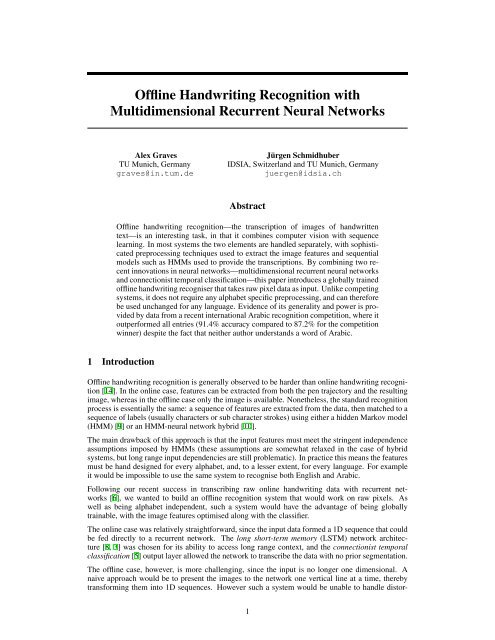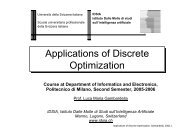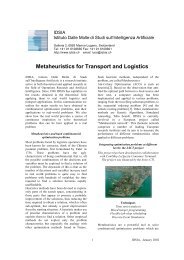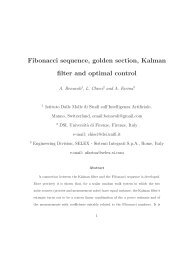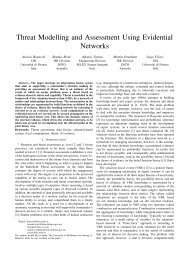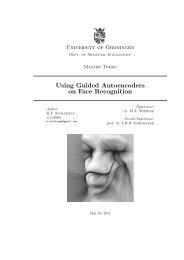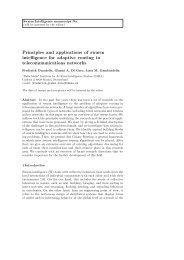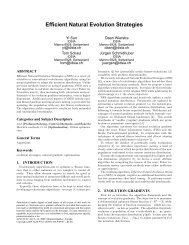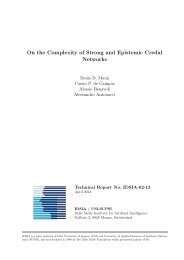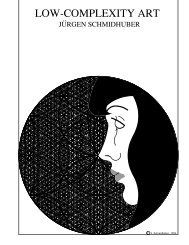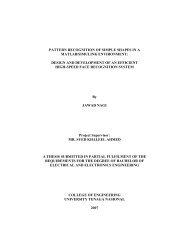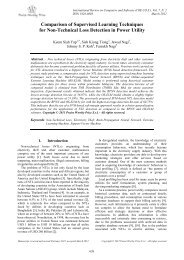Offline Handwriting Recognition with Multidimensional ... - Idsia
Offline Handwriting Recognition with Multidimensional ... - Idsia
Offline Handwriting Recognition with Multidimensional ... - Idsia
Create successful ePaper yourself
Turn your PDF publications into a flip-book with our unique Google optimized e-Paper software.
<strong>Offline</strong> <strong>Handwriting</strong> <strong>Recognition</strong> <strong>with</strong><br />
<strong>Multidimensional</strong> Recurrent Neural Networks<br />
Alex Graves<br />
TU Munich, Germany<br />
graves@in.tum.de<br />
Jürgen Schmidhuber<br />
IDSIA, Switzerland and TU Munich, Germany<br />
juergen@idsia.ch<br />
Abstract<br />
<strong>Offline</strong> handwriting recognition—the transcription of images of handwritten<br />
text—is an interesting task, in that it combines computer vision <strong>with</strong> sequence<br />
learning. In most systems the two elements are handled separately, <strong>with</strong> sophisticated<br />
preprocessing techniques used to extract the image features and sequential<br />
models such as HMMs used to provide the transcriptions. By combining two recent<br />
innovations in neural networks—multidimensional recurrent neural networks<br />
and connectionist temporal classification—this paper introduces a globally trained<br />
offline handwriting recogniser that takes raw pixel data as input. Unlike competing<br />
systems, it does not require any alphabet specific preprocessing, and can therefore<br />
be used unchanged for any language. Evidence of its generality and power is provided<br />
by data from a recent international Arabic recognition competition, where it<br />
outperformed all entries (91.4% accuracy compared to 87.2% for the competition<br />
winner) despite the fact that neither author understands a word of Arabic.<br />
1 Introduction<br />
<strong>Offline</strong> handwriting recognition is generally observed to be harder than online handwriting recognition<br />
[14]. In the online case, features can be extracted from both the pen trajectory and the resulting<br />
image, whereas in the offline case only the image is available. Nonetheless, the standard recognition<br />
process is essentially the same: a sequence of features are extracted from the data, then matched to a<br />
sequence of labels (usually characters or sub character strokes) using either a hidden Markov model<br />
(HMM) [9] or an HMM-neural network hybrid [10].<br />
The main drawback of this approach is that the input features must meet the stringent independence<br />
assumptions imposed by HMMs (these assumptions are somewhat relaxed in the case of hybrid<br />
systems, but long range input dependencies are still problematic). In practice this means the features<br />
must be hand designed for every alphabet, and, to a lesser extent, for every language. For example<br />
it would be impossible to use the same system to recognise both English and Arabic.<br />
Following our recent success in transcribing raw online handwriting data <strong>with</strong> recurrent networks<br />
[6], we wanted to build an offline recognition system that would work on raw pixels. As<br />
well as being alphabet independent, such a system would have the advantage of being globally<br />
trainable, <strong>with</strong> the image features optimised along <strong>with</strong> the classifier.<br />
The online case was relatively straightforward, since the input data formed a 1D sequence that could<br />
be fed directly to a recurrent network. The long short-term memory (LSTM) network architecture<br />
[8, 3] was chosen for its ability to access long range context, and the connectionist temporal<br />
classification [5] output layer allowed the network to transcribe the data <strong>with</strong> no prior segmentation.<br />
The offline case, however, is more challenging, since the input is no longer one dimensional. A<br />
naive approach would be to present the images to the network one vertical line at a time, thereby<br />
transforming them into 1D sequences. However such a system would be unable to handle distor-<br />
1
Figure 1: Two dimensional MDRNN. The thick lines show connections to the current point (i, j).<br />
The connections <strong>with</strong>in the hidden layer plane are recurrent. The dashed lines show the scanning<br />
strips along which previous points were visited, starting at the top left corner.<br />
tions along the vertical axis; for example the same image shifted up by one pixel would appear<br />
completely different. A more flexible solution is offered by multidimensional recurrent neural networks<br />
(MDRNNs) [7]. MDRNNs, which are a special case of directed acyclic graph networks [1],<br />
generalise standard RNNs by providing recurrent connections along all spatio-temporal dimensions<br />
present in the data. These connections make MDRNNs robust to local distortions along any combination<br />
of input dimensions (e.g. image rotations and shears, which mix vertical and horizontal<br />
displacements) and allow them to model multidimensional context in a flexible way. We use multidimensional<br />
LSTM because it is able to access long range context.<br />
The problem remains, though, of how to transform two dimensional images into one dimensional<br />
label sequences. Our solution is to pass the data through a hierarchy of MDRNN layers, <strong>with</strong><br />
blocks of activations gathered together after each level. The heights of the blocks are chosen to<br />
incrementally collapse the 2D images onto 1D sequences, which can then be labelled by the output<br />
layer. Such hierarchical structures are common in computer vision [15], because they allow complex<br />
features to be built up in stages. In particular our multilayered structure is similar to that used by<br />
convolution networks [11], although it should be noted that because convolution networks are not<br />
recurrent, they cannot be used for cursive handwriting recognition <strong>with</strong>out presegmented inputs.<br />
Our method is described in detail in Section 2, experimental results are given in Section 3, and<br />
conclusions and directions for future work are given in Section 4.<br />
2 Method<br />
The three components of our recognition system are: (1) multidimensional recurrent neural networks,<br />
and multidimensional LSTM in particular; (2) the connectionist temporal classification output<br />
layer; and (3) the hierarchical structure. In what follows we describe each component in turn,<br />
then show how they fit together to form a complete system. For a more detailed description of (1)<br />
and (2) we refer the reader to [4]<br />
2.1 <strong>Multidimensional</strong> Recurrent Neural Networks<br />
The basic idea of multidimensional recurrent neural networks (MDRNNs) [7] is to replace the single<br />
recurrent connection found in standard recurrent networks <strong>with</strong> as many connections as there are<br />
spatio-temporal dimensions in the data. These connections allow the network to create a flexible<br />
internal representation of surrounding context, which is robust to localised distortions.<br />
An MDRNN hidden layer scans through the input in 1D strips, storing its activations in a buffer. The<br />
strips are ordered in such a way that at every point the layer has already visited the points one step<br />
back along every dimension. The hidden activations at these previous points are fed to the current<br />
point through recurrent connections, along <strong>with</strong> the input. The 2D case is illustrated in Fig. 1.<br />
One such layer is sufficient to give the network access to all context against the direction of scanning<br />
from the current point (e.g. to the top and left of (i, j) in Fig. 1). However we usually want<br />
surrounding context in all directions. The same problem exists in 1D networks, where it is often<br />
useful to have information about the future as well as the past. The canonical 1D solution is bidi-<br />
2
ectional recurrent networks [16], where two separate hidden layers scan through the input forwards<br />
and backwards. The generalisation of bidirectional networks to n dimensions requires 2 n hidden<br />
layers, starting in every corner of the n dimensional hypercube and scanning in opposite directions.<br />
For example, a 2D network has four layers, one starting in the top left and scanning down and right,<br />
one starting in the bottom left and scanning up and right, etc. All the hidden layers are connected to<br />
a single output layer, which therefore receives information about all surrounding context.<br />
The error gradient of an MDRNN can be calculated <strong>with</strong> an n-dimensional extension of backpropagation<br />
through time. As in the 1D case, the data is processed in the reverse order of the forward<br />
pass, <strong>with</strong> each hidden layer receiving both the output derivatives and its own n ‘future’ derivatives<br />
at every timestep.<br />
Let a p j and bp j be respectively the input and activation of unit j at point p =(p 1, . . . , p n ) in an n-<br />
dimensional input sequence x <strong>with</strong> dimensions (D 1 , . . . , D n ). Let p − d =(p 1, . . . , p d − 1, . . . , p n )<br />
and p + d<br />
=(p 1, . . . , p d +1, . . . , p n ). Let w ij and wij d be respectively the weight of the feedforward<br />
connection from unit i to unit j and the recurrent connection from i to j along dimension d. Let θ h<br />
be the activation function of hidden unit h, and for some unit j and some differentiable objective<br />
function O let δ p j = ∂O . Then the forward and backward equations for an n-dimensional MDRNN<br />
∂a p j<br />
<strong>with</strong> I input units, K output units, and H hidden summation units are as follows:<br />
Forward Pass<br />
IX<br />
a p h = x p i w ih +<br />
i=1<br />
b p h = θ h(a p h )<br />
nX<br />
HX<br />
d=1: h ′ =1<br />
p d >0<br />
b p− d<br />
h<br />
w d ′ h ′ h<br />
Backward Pass<br />
0<br />
δ p h = θ′ h(a p h ) B<br />
@<br />
KX<br />
δ p k w hk +<br />
k=1<br />
nX<br />
HX<br />
d=1: h ′ =1<br />
p d 0<br />
0<br />
Forget Gate: b p φ,d = IX<br />
f1 B<br />
@ x p i w i(φ,d) +<br />
i=1<br />
w cιs p− d<br />
c +<br />
nX<br />
HX<br />
d ′ =1: h=1<br />
p d ′ >0<br />
HX<br />
h=1<br />
b p− d<br />
h wd hι! 1 C A<br />
b p− d ′<br />
h<br />
wd′ h(φ,d) +<br />
(<br />
w c(φ,d) s p− d<br />
c if p d > 0<br />
0 otherwise<br />
1<br />
C<br />
A<br />
3
Backward Pass<br />
Cell: a p c =<br />
IX<br />
x p i wic +<br />
i=1<br />
0<br />
Output Gate: b p B<br />
ω = f 1 @<br />
n<br />
X<br />
HX<br />
d=1: h=1<br />
p d >0<br />
IX<br />
x p i wiω +<br />
i=1<br />
Cell Output: b p c = b p ωf 3(s p c )<br />
Cell Output: ɛ p c<br />
def<br />
= ∂O<br />
∂b p c<br />
=<br />
KX<br />
δ p k w ck +<br />
k=1<br />
Output Gate: δ p ω = f ′ 1(a p ω)ɛ p c f 3(s p c )<br />
State: ɛ p s<br />
def<br />
= ∂O<br />
∂s p c<br />
b p− d<br />
h wd hc State: s p c = b p ι f 2(a p c )+<br />
n<br />
X<br />
HX<br />
d=1: h=1<br />
p d >0<br />
= b p ωf ′ 3(s p c )ɛ p c + δ p ωw cω +<br />
nX<br />
b p− d<br />
h<br />
d=1: h=1<br />
p d 0<br />
0 otherwise<br />
Input Gate: δ p ι = f ′ 1(a p ι )f 2(a p c )ɛ p s<br />
«<br />
2.2 Connectionist Temporal Classification<br />
Connectionist temporal classification (CTC) [5] is an output layer designed for sequence labelling<br />
<strong>with</strong> RNNs. Unlike other neural network output layers it does not require pre-segmented training<br />
data, or postprocessing to transform its outputs into transcriptions. Instead, it trains the network to<br />
directly estimate the conditional probabilities of the possible labellings given the input sequences.<br />
A CTC output layer contains one more unit than there are elements in the alphabet L of labels for<br />
the task. The output activations are normalised <strong>with</strong> the softmax activation function [2]. At each<br />
timestep, the first |L| outputs are estimate the probabilities of observing the corresponding labels,<br />
and the extra output estimates the probability of observing a ‘blank’, or no label. The combined<br />
output sequence estimates the joint probability of all possible alignments of the input sequence <strong>with</strong><br />
labels and blanks. The probability of a particular labelling can then be estimated by summing over<br />
the probabilities of all the alignments that correspond to it.<br />
More precisely, for a length T input sequence x, the CTC outputs define a probability distribution<br />
over the set L ′T of length T sequences over the alphabet L ′ = L ∪{blank}. To distinguish them<br />
from labellings, we refer to the elements of L ′T as paths. Since the probabilities of the labels at<br />
each timestep are conditionally independent given x, the conditional probability of a path π ∈ L ′ T<br />
is given by p(π|x) = ∏ T<br />
t=1 yt π t<br />
. where yk t is the activation of output unit k at time t.<br />
Paths are mapped onto labellings l ∈ L ≤T by an operator B that removes first the repeated labels,<br />
then the blanks. For example, both B(a, −, a, b, −) and B(−, a, a, −, −, a, b, b) yield the labelling<br />
(a, a, b). Since the paths are mutually exclusive, the conditional probability of some labelling l ∈<br />
L ≤T is the sum of the probabilities of all paths corresponding to it: p(l|x) = ∑ π∈B −1 (l) p(π|x).<br />
Although a naive calculation of this sum is unfeasible, it can be efficiently evaluated <strong>with</strong> a dynamic<br />
programming algorithm, similar to the forward-backward algorithm for HMMs.<br />
To allow for blanks in the output paths, for each labelling l ∈ L ≤T consider a modified labelling<br />
l ′ ∈ L ′ ≤T , <strong>with</strong> blanks added to the beginning and the end and inserted between every pair of labels.<br />
The length of l ′ is therefore |l ′ | =2|l| +1.<br />
For a labelling l, define the forward variable α t (s) as the summed probability of all path beginnings<br />
reaching index s of l ′ at time t, and the backward variables β t (s) as the summed probability of all<br />
path endings that would complete the labelling l if the path beginning had reached s at time t. Both<br />
4
the forward and backward variables are calculated recursively [5]. The label sequence probability<br />
is given by the sum of the products of the forward and backward variables at any timestep, i.e.<br />
p(l|x) = ∑ |l ′ |<br />
s=1 α t(s)β t (s).<br />
The objective function O for CTC is the negative log probability of the network correctly labelling<br />
the entire training set. Let S be a training set, consisting of pairs of input and target sequences<br />
(x, z), where |z| ≤ |x|. Then O = − ∑ (x,z)∈S<br />
ln p(z|x). The network can be trained <strong>with</strong> gradient<br />
descent by first differentiating O <strong>with</strong> respect to the outputs, then using backpropagation through<br />
time to find the derivatives <strong>with</strong> respect to the weights.<br />
Note that the same label (or blank) may be repeated several times for a single labelling l. We define<br />
the set of positions where label k occurs as lab(l,k) = {s : l ′ s = k}, which may be empty.<br />
Setting l = z and differentiating O <strong>with</strong> respect to the network outputs, we obtain:<br />
∂ ln p(z|x)<br />
−<br />
∂a t = yk t − 1<br />
k<br />
p(z|x)<br />
∑<br />
s∈lab(z,k)<br />
α t (s)β t (s),<br />
where a t k and yt k<br />
are respectively the input and output of CTC unit k at time t.<br />
Once the network is trained, we can label some unknown input sequence x by choosing the labelling<br />
l ∗ <strong>with</strong> the highest conditional probability, i.e. l ∗ = arg max l p(l|x). In cases where a dictionary<br />
is used, the labelling can be constrained to yield only sequences of complete words by using the<br />
CTC token passing algorithm [6]. For the experiments in this paper, the labellings were further<br />
constrained to give single word sequences only, and the ten most probable words were recorded.<br />
2.3 Network Hierarchy<br />
Many computer vision systems use a hierarchical approach to feature extraction, <strong>with</strong> the features<br />
at each level used as input to the next level [15]. This allows complex visual properties to be built<br />
up in stages. Typically, such systems use subsampling, <strong>with</strong> the feature resolution decreased at each<br />
stage. They also generally have more features at the higher levels. The basic idea is to progress from<br />
a small number of simple local features to a large number of complex global features.<br />
We created a hierarchical structure by repeatedly composing MDLSTM layers <strong>with</strong> feedforward<br />
layers. The basic procedure is as follows: (1) the image is divided into small pixel blocks, each of<br />
which is presented as a single input to the first set of MDLSTM layers (e.g. a 4x3 block is reduced<br />
to a length 12 vector). If the image does not divide exactly into blocks, it is padded <strong>with</strong> zeros.<br />
(2) the four MDLSTM layers scan through the pixel blocks in all directions. (3) the activations of<br />
the MDLSTM layers are collected into blocks. (4) these blocks are given as input to a feedforward<br />
layer. Note that all the layers have a 2D array of activations: e.g. a 10 unit feedforward layer <strong>with</strong><br />
input from a 5x5 array of MDLSTM blocks has a total of 250 activations.<br />
The above process is repeated as many times as required, <strong>with</strong> the activations of the feedforward<br />
layer taking the place of the original image. The purpose of the blocks is twofold: to collect local<br />
contextual information, and to reduce the area of the activation arrays. In particular, we want to<br />
reduce the vertical dimension, since the CTC output layer requires a 1D sequence as input. Note<br />
that the blocks themselves do not reduce the overall amount of data; that is done by the layers that<br />
process them, which are therefore analogous to the subsampling steps in other approaches (although<br />
<strong>with</strong> trainable weights rather than a fixed subsampling function).<br />
For most tasks we find that a hierarchy of three MDLSTM/feedforward stages gives the best results.<br />
We use the standard ‘inverted pyramid’ structure, <strong>with</strong> small layers at the bottom and large layers at<br />
the top. As well as allowing for more features at higher levels, this leads to efficient networks, since<br />
most of the weights are concentrated in the upper layers, which have a smaller input area.<br />
In general we cannot assume that the input images are of fixed size. Therefore it is difficult to choose<br />
block heights that ensure that the final activation array will always be one dimensional, as required<br />
by CTC. A simple solution is to collapse the final array by summing over all the inputs in each<br />
vertical line, i.e. the input at time t to CTC unit k is given by a t k = ∑ x a(x,t) k<br />
, where a (x,y)<br />
k<br />
is the<br />
uncollapsed input to unit k at point (x, y) in the final array.<br />
5
Figure 2: The complete recognition system. First the input image is collected into boxes 3 pixels<br />
wide and 4 pixels high which are then scanned by four MDLSTM layers. The activations of the cells<br />
in each layer are displayed separately, and the arrows in the corners indicates the scanning direction.<br />
Next the MDLSTM activations are gathered into 4 x 3 boxes and fed to a feedforward layer of tanh<br />
summation units. This process is repeated two more times, until the final MDLSTM activations are<br />
collapsed to a 1D sequence and transcribed by the CTC layer. In this case all characters are correctly<br />
labelled except the second last one, and the correct town name is chosen from the dictionary.<br />
3 Experiments<br />
To see how our method compared to the state of the art, we applied it to data from the ICDAR<br />
2007 Arabic handwriting recognition competition [12]. Although we were too late to enter the<br />
competition itself, the organisers kindly agreed to evaluate our system according to the competition<br />
criteria. We did not receive the test data at any point, and all evaluations were carried out by them.<br />
The goal of the competition was to identify the postcodes of Tunisian town and village names. The<br />
names are presented individually, so this is an isolated word recognition task. However we would<br />
like to point out that our system is equally applicable to unconstrained handwriting, and has been<br />
successfully applied to complete lines of English text.<br />
3.1 Data<br />
The competition was based on the IFN/ENIT database of handwritten Arabic words [13]. The<br />
publically available data consists of 32,492 images of handwritten Tunisian town names, of which<br />
we used 30,000 for training, and 2,492 for validation. The images were extracted from artificial<br />
6
Table 1: Results on the ICDAR 2007 Arabic handwriting recognition contest. All scores are<br />
percentages of correctly identified postcodes. The systems are ordered by the ‘top 1’ results on test<br />
set ‘f’. The best score in each column is shown in bold.<br />
SET f<br />
SET s<br />
SYSTEM top 1 top 5 top 10 top 1 top 5 top 10<br />
CACI-3 14.28 29.88 37.91 10.68 21.74 30.20<br />
CACI-2 15.79 21.34 22.33 14.24 19.39 20.53<br />
CEDAR 59.01 78.76 83.70 41.32 61.98 69.87<br />
MITRE 61.70 81.61 85.69 49.91 70.50 76.48<br />
UOB-ENST-1 79.10 87.69 90.21 64.97 78.39 82.20<br />
PARIS V 80.18 91.09 92.98 64.38 78.12 82.13<br />
ICRA 81.47 90.07 92.15 72.22 82.84 86.27<br />
UOB-ENST-2 81.65 90.81 92.35 69.61 83.79 85.89<br />
UOB-ENST-4 81.81 88.71 90.40 70.57 79.85 83.34<br />
UOB-ENST-3 81.93 91.20 92.76 69.93 84.11 87.03<br />
SIEMENS-1 82.77 92.37 93.92 68.09 81.70 85.19<br />
MIE 83.34 91.67 93.48 68.40 80.93 83.73<br />
SIEMENS-2 87.22 94.05 95.42 73.94 85.44 88.18<br />
Ours 91.43 96.12 96.75 78.83 88.00 91.05<br />
forms filled in by over 400 Tunisian people. The forms were designed to simulate writing on a<br />
letter, and contained no lines or boxes to constrain the writing style.<br />
Each image was supplied <strong>with</strong> a ground truth transcription for the individual characters 1 . There were<br />
120 distinct characters in total. A list of 937 town names and postcodes was provided. Many of the<br />
town names had transcription variants, giving a total of 1,518 entries in the complete dictionary.<br />
The test data (which is not published) is divided into sets ‘f’ and ‘s’. The main competition results<br />
were based on set ‘f’. Set ‘s’ contains data collected in the United Arab Emirates using the same<br />
forms; its purpose was to test the robustness of the recognisers to regional writing variations. The<br />
systems were allowed to choose up to 10 postcodes for each image, in order of preference. The test<br />
set performance using the top 1, top 5, and top 10 answers was recorded by the organisers.<br />
3.2 Network Parameters<br />
The structure shown in Figure 2 was used, <strong>with</strong> each layer fully connected to the next layer in the<br />
hierarchy, all MDLSTM layers connected to themselves, and all units connected to a bias weight.<br />
There were 159,369 weights in total. This may sound like a lot, but as mentioned in Section 2.3, the<br />
‘inverted pyramid’ structure greatly reduces the actual number of weight operations. In effect the<br />
higher up networks (where the vast majority of the weights are concentrated) are processing much<br />
smaller images than those lower down. The squashing function for the gates was the logistic sigmoid<br />
f 1 (x) = 1/(1 + e −x ), while tanh was used for f 2 and f 3 . Each pass through the training set took<br />
about an hour on a desktop computer, and the network converged after 85 passes.<br />
The complete system was trained <strong>with</strong> online gradient descent, using a learning rate of 10 −4 and<br />
a momentum of 0.9. The character error rate was evaluated on the validation set after every pass<br />
through the training set, and training was stopped after 50 evaluations <strong>with</strong> no improvement. The<br />
weights giving the lowest error rate on the validation set were passed to the competition organisers<br />
for assessment on the test sets.<br />
3.3 Results<br />
Table 1 clearly shows that our system outperformed all entries in the 2007 ICDAR Arabic recognition<br />
contest. The other systems, most of which are based on HMMs, are identified by the names of<br />
the groups that submitted them (see [12] for more information).<br />
1 At first we forgot that Arabic reads right to left and presented the transcriptions backwards. The system<br />
performed surprisingly well, <strong>with</strong> a character error rate of 17.8%, compared to 10.7% for the correct targets.<br />
7
4 Conclusions and Future Work<br />
We have combined multidimensional LSTM <strong>with</strong> connectionist temporal classification and a hierarchical<br />
layer structure to create a powerful offline handwriting recogniser. The system is very general,<br />
and has been successfully applied to English as well as Arabic. Indeed, since the dimensionality of<br />
the networks can be changed to match that of the data, it could be used for almost any supervised<br />
sequence labelling task. We are currently investigating applications to facial expression recognition.<br />
Acknowledgements<br />
We would like to thank Haikal El Abed for giving us access to the ICDAR competition data, and<br />
for persisting in the face of technical despair to install and evaluate our software. This work was<br />
supported by the excellence cluster “Cognition for Technical Systems” (CoTeSys) from the German<br />
Research Foundation (DFG).<br />
References<br />
[1] P. Baldi and G. Pollastri. The principled design of large-scale recursive neural network architectures–dagrnns<br />
and the protein structure prediction problem. J. Mach. Learn. Res., 4:575–602, 2003.<br />
[2] J. S. Bridle. Probabilistic interpretation of feedforward classification network outputs, <strong>with</strong> relationships<br />
to statistical pattern recognition. In F. Fogleman-Soulie and J.Herault, editors, Neurocomputing: Algorithms,<br />
Architectures and Applications, pages 227–236. Springer-Verlag, 1990.<br />
[3] F. Gers, N. Schraudolph, and J. Schmidhuber. Learning precise timing <strong>with</strong> LSTM recurrent networks.<br />
Journal of Machine Learning Research, 3:115–143, 2002.<br />
[4] A. Graves. Supervised Sequence Labelling <strong>with</strong> Recurrent Neural Networks. PhD thesis.<br />
[5] A. Graves, S. Fernández, F. Gomez, and J. Schmidhuber. Connectionist temporal classification: Labelling<br />
unsegmented sequence data <strong>with</strong> recurrent neural networks. In Proceedings of the International<br />
Conference on Machine Learning, ICML 2006, Pittsburgh, USA, 2006.<br />
[6] A. Graves, S. Fernández, M. Liwicki, H. Bunke, and J. Schmidhuber. Unconstrained online handwriting<br />
recognition <strong>with</strong> recurrent neural networks. In J. Platt, D. Koller, Y. Singer, and S. Roweis, editors,<br />
Advances in Neural Information Processing Systems 20. MIT Press, Cambridge, MA, 2008.<br />
[7] A. Graves, S. Fernández, and J. Schmidhuber. <strong>Multidimensional</strong> recurrent neural networks. In Proceedings<br />
of the 2007 International Conference on Artificial Neural Networks, Porto, Portugal, September<br />
2007.<br />
[8] S. Hochreiter and J. Schmidhuber. Long Short-Term Memory. Neural Computation, 9(8):1735–1780,<br />
1997.<br />
[9] J. Hu, S. G. Lim, and M. K. Brown. Writer independent on-line handwriting recognition using an HMM<br />
approach. Pattern <strong>Recognition</strong>, 33:133–147, 2000.<br />
[10] S. Jaeger, S. Manke, J. Reichert, and A. Waibel. On-line handwriting recognition: the NPen++ recognizer.<br />
International Journal on Document Analysis and <strong>Recognition</strong>, 3:169–180, 2001.<br />
[11] Y. LeCun, L. Bottou, Y. Bengio, and P. Haffner. Gradient-based learning applied to document recognition.<br />
Proceedings of the IEEE, 86(11):2278–2324, November 1998.<br />
[12] V. Margner and H. E. Abed. Arabic handwriting recognition competition. In ICDAR ’07: Proceedings of<br />
the Ninth International Conference on Document Analysis and <strong>Recognition</strong> (ICDAR 2007) Vol 2, pages<br />
1274–1278, Washington, DC, USA, 2007. IEEE Computer Society.<br />
[13] M. Pechwitz, S. S. Maddouri, V. Mrgner, N. Ellouze, and H. Amiri. IFN/ENIT-database of handwritten<br />
arabic words. In 7th Colloque International Francophone sur l’Ecrit et le Document (CIFED 2002),<br />
Hammamet, Tunis, 2002.<br />
[14] R. Plamondon and S. N. Srihari. On-line and off-line handwriting recognition: a comprehensive survey.<br />
IEEE Transactions on Pattern Analysis and Machine Intelligence, 2000.<br />
[15] M. Reisenhuber and T. Poggio. Hierarchical models of object recognition in cortex. Nature Neuroscience,<br />
2(11):1019–1025, 1999.<br />
[16] M. Schuster and K. K. Paliwal. Bidirectional recurrent neural networks. IEEE Transactions on Signal<br />
Processing, 45:2673–2681, November 1997.<br />
8


